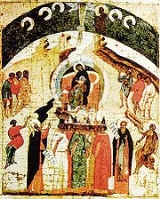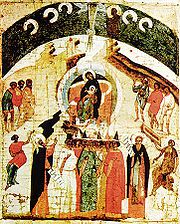
Synaxis
Encyclopedia

Eastern Christianity
Eastern Christianity comprises the Christian traditions and churches that developed in the Balkans, Eastern Europe, Asia Minor, the Middle East, Northeastern Africa, India and parts of the Far East over several centuries of religious antiquity. The term is generally used in Western Christianity to...
(the Orthodox Church and those Eastern Catholic Churches which follow the Byzantine Rite
Byzantine Rite
The Byzantine Rite, sometimes called the Rite of Constantinople or Constantinopolitan Rite is the liturgical rite used currently by all the Eastern Orthodox Churches, by the Greek Catholic Churches , and by the Protestant Ukrainian Lutheran Church...
), a Synaxis is an assembly for liturgical purposes, generally through the celebration of Vespers
Vespers
Vespers is the evening prayer service in the Western Catholic, Eastern Catholic, and Eastern Orthodox, Anglican, and Lutheran liturgies of the canonical hours...
, Matins
Matins
Matins is the early morning or night prayer service in the Roman Catholic, Anglican, Lutheran and Eastern Orthodox liturgies of the canonical hours. The term is also used in some Protestant denominations to describe morning services.The name "Matins" originally referred to the morning office also...
, Little Hours
Little Hours
The Little Hours are the fixed daytime hours of prayer in the Divine Office of Christians, in both Western Christianity and the Eastern Orthodox Church. These Hours are called 'little' due to their shorter and simpler structure compared to the Night Hours...
, and the Divine Liturgy
Divine Liturgy
Divine Liturgy is the common term for the Eucharistic service of the Byzantine tradition of Christian liturgy. As such, it is used in the Eastern Orthodox and Eastern Catholic Churches. Armenian Christians, both of the Armenian Apostolic Church and of the Armenian Catholic Church, use the same term...
.
Feast day
In ConstantinopleConstantinople
Constantinople was the capital of the Roman, Eastern Roman, Byzantine, Latin, and Ottoman Empires. Throughout most of the Middle Ages, Constantinople was Europe's largest and wealthiest city.-Names:...
, the clergy and faithful would often gather together on specific feast days at a church dedicated to the saint of that day for liturgical celebrations. These gatherings were referred to as synaxes. These synaxes came to have services written specifically for them. A Synaxis often occurs on the day following a Major Feast Day and is in honor of saints who participated in the event. For example, services on the Feast of Theophany (the revelation of the Trinity
Trinity
The Christian doctrine of the Trinity defines God as three divine persons : the Father, the Son , and the Holy Spirit. The three persons are distinct yet coexist in unity, and are co-equal, co-eternal and consubstantial . Put another way, the three persons of the Trinity are of one being...
at the Baptism of Jesus
Baptism of Jesus
The baptism of Jesus marks the beginning of Jesus Christ's public ministry. This event is recorded in the Canonical Gospels of Matthew, Mark and Luke. In John 1:29-33 rather than a direct narrative, the Baptist bears witness to the episode...
in the Jordan) would be held at Hagia Sophia
Hagia Sophia
Hagia Sophia is a former Orthodox patriarchal basilica, later a mosque, and now a museum in Istanbul, Turkey...
; then, the next day, a Synaxis was observed in honor of St. John the Forerunner
John the Baptist
John the Baptist was an itinerant preacher and a major religious figure mentioned in the Canonical gospels. He is described in the Gospel of Luke as a relative of Jesus, who led a movement of baptism at the Jordan River...
at the church dedicated to him. Over time, the synaxes came into general use and are now celebrated in every church.
Synaxis can also refer to a common commemoration of a number of saints in a single service, such as the Synaxis of the Seventy Apostles. Each individual saint may have his or her own separate feast day, but they are all commemorated together on their synaxis.
Most synaxes are observed as fixed feasts
Eastern Orthodox liturgical calendar
The Eastern Orthodox liturgical calendar describes and dictates the rhythm of the life of the Eastern Orthodox Church. Associated with each date are passages of Holy Scripture, Saints and events for commemoration, and many times special rules for fasting or feasting that correspond to the day of...
, being celebrated on the same calendar date year after year, though some occur on the nearest Sunday to a particular date. Other synaxes are celebrated on the Paschal cycle
Paschal cycle
The Paschal cycle in the Eastern and Oriental Orthodox Churches, is the cycle of the moveable feasts built around Pascha . The cycle consists of approximately ten weeks before and seven weeks after Pascha. The ten weeks before Pascha are known as the period of the Triodion...
, moving backward or forward in the calendar according to the date of Pascha
Easter
Easter is the central feast in the Christian liturgical year. According to the Canonical gospels, Jesus rose from the dead on the third day after his crucifixion. His resurrection is celebrated on Easter Day or Easter Sunday...
(Easter) that year.
The following are Synaxes which are universally observed in the Rite of Constantinople:
- Synaxis of the Theotokos (December 26)
- Synaxis of the Forerunner (January 7)
- Synaxis of the Seventy Apostles (January 4)
- Synaxis of the Three Great Hierarchs (January 30)
- Synaxis of the Archangel Gabriel (March 26 and July 13)
- Synaxis of the Twelve Apostles (June 30)
- Synaxis of the Holy Fathers of the Second Ecumenical Council (May 22)
- Synaxis of the Holy Fathers of the Fifth Ecumenical Council (July 25)
- Synaxis of the Holy Fathers of the Third Ecumenical Council (September 9)
- Synaxis of the Archangel Michael and the Other Bodiless Powers (November 8)
- Synaxis of the Holy Unmercenaries (November 1)
- Synaxis of the Holy Fathers of the First Ecumenical Council (Sunday before PentecostPentecostPentecost is a prominent feast in the calendar of Ancient Israel celebrating the giving of the Law on Sinai, and also later in the Christian liturgical year commemorating the descent of the Holy Spirit upon the disciples of Christ after the Resurrection of Jesus...
and May 29) - Synaxis of All Saints (Sunday after Pentecost)
- Synaxis of the Holy Fathers of the Seventh Ecumenical Council (Sunday on or after October 8)
- Synaxis of the Holy Fathers of the Sixth Ecumenical Council (January 23)
There are also synaxes which have been composed for local observance:
- Synaxis of the Saints of Belarus
- Synaxis of the Saints of North America (second Sunday after Pentecost)
- Synaxis of all Saints of Pskov (third Sunday after Pentecost)
- Synaxis of the Saints of Kostroma (January 23)
- Synaxis of the Hierarchs of Novgorod (February 10, October 4, and the third Sunday after Pentecost)
- Synaxis of the Venerable Fathers of the Kiev Caves Lavra (second Sunday of Great LentGreat LentGreat Lent, or the Great Fast, is the most important fasting season in the church year in Eastern Christianity, which prepares Christians for the greatest feast of the church year, Pascha . In many ways Great Lent is similar to Lent in Western Christianity...
) - Synaxis of the Rostov and Yaroslavl (May 23)
- Synaxis of the Saints of Ryzan (June 10)
- Synaxis of the Saints of Siberia (June 10)
- Synaxis of the Saints of Vladimir (June 23)
- Synaxis of the Saints of Radonezh (July 6)
- Synaxis of the Saints of Solovki Monastery (August 9)
- Synaxis of the Venerable Fathers of the Far Caves in Kiev (August 28)
- Synaxis of the Serbian Hierarchs (August 30)
- Synaxis of the Saints of Tula (September 22)
- Synaxis of All Saints of Alaska (September 24)
- Synaxis of the Venerable Fathers of the Near Caves in Kiev (September 28)
- Synaxis of the Hierarchs of Kazan (October 4)
- Synaxis of the Saints of Volhynia (October 10)
- Synaxis of the Saints of Belarus (second Sunday after Pentecost)
- Synaxis of the Venerable Fathers of Optina (October 11)
- Synaxis of the Saints of Georgia (December 11)
- Synaxis of all Saints of Serbia (August 28)
- Synaxis of the Hierarchs of Moscow (October 5)
- Synaxis of all Saints of MoscowMoscowMoscow is the capital, the most populous city, and the most populous federal subject of Russia. The city is a major political, economic, cultural, scientific, religious, financial, educational, and transportation centre of Russia and the continent...
(Sunday before August 26) - Synaxis of the Saints of Smolensk (Sunday closest to July 23)
- Synaxis of the Saints of TverTverTver is a city and the administrative center of Tver Oblast, Russia. Population: 403,726 ; 408,903 ;...
(Sunday closest to July 3)
Assembly
A Synaxis is a group of churchmen - especially in the Orthodox ChurchEastern Orthodox Church
The Orthodox Church, officially called the Orthodox Catholic Church and commonly referred to as the Eastern Orthodox Church, is the second largest Christian denomination in the world, with an estimated 300 million adherents mainly in the countries of Belarus, Bulgaria, Cyprus, Georgia, Greece,...
- who would otherwise compose a Synod
Synod
A synod historically is a council of a church, usually convened to decide an issue of doctrine, administration or application. In modern usage, the word often refers to the governing body of a particular church, whether its members are meeting or not...
but lack an officiating Patriarch
Patriarch
Originally a patriarch was a man who exercised autocratic authority as a pater familias over an extended family. The system of such rule of families by senior males is called patriarchy. This is a Greek word, a compound of πατριά , "lineage, descent", esp...
.
Because they did not recognize the authority of the Latin
Latins
"Latins" refers to different groups of people and the meaning of the word changes for where and when it is used.The original Latins were an Italian tribe inhabiting central and south-central Italy. Through conquest by their most populous city-state, Rome, the original Latins culturally "Romanized"...
Patriarchs
Latin Patriarch of Constantinople
The Latin Patriarch of Constantinople was an office established as a result of Crusader activity in the Near East. The title should not be confused with that of the Patriarch of Constantinople, an office which existed before and after....
following the Council of Florence
Council of Florence
The Council of Florence was an Ecumenical Council of the Roman Catholic Church. It began in 1431 in Basel, Switzerland, and became known as the Council of Ferrara after its transfer to Ferrara was decreed by Pope Eugene IV, to convene in 1438...
, the group of churchmen opposing the Council and its Union called themselves the Synaxis. The most influential and famous of these was the monk Gennadios, better known as Georgios Scholarios, who later became Ecumenical Patriarch of Constantinople.

